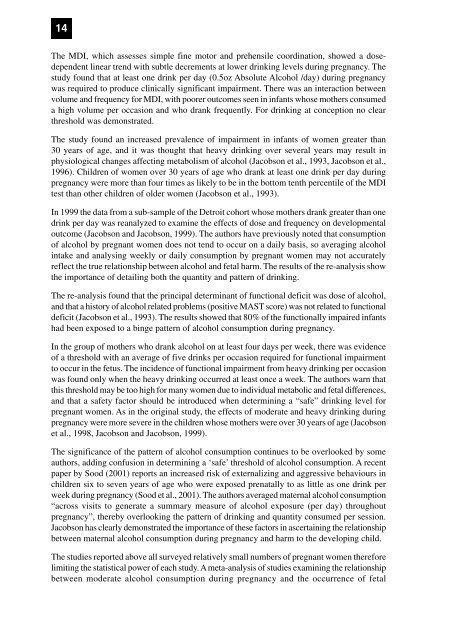Fetal Alcohol Syndrome A literature review - Department of Health ...
Fetal Alcohol Syndrome A literature review - Department of Health ...
Fetal Alcohol Syndrome A literature review - Department of Health ...
Create successful ePaper yourself
Turn your PDF publications into a flip-book with our unique Google optimized e-Paper software.
14<br />
The MDI, which assesses simple fine motor and prehensile coordination, showed a dosedependent<br />
linear trend with subtle decrements at lower drinking levels during pregnancy. The<br />
study found that at least one drink per day (0.5oz Absolute <strong>Alcohol</strong> /day) during pregnancy<br />
was required to produce clinically significant impairment. There was an interaction between<br />
volume and frequency for MDI, with poorer outcomes seen in infants whose mothers consumed<br />
a high volume per occasion and who drank frequently. For drinking at conception no clear<br />
threshold was demonstrated.<br />
The study found an increased prevalence <strong>of</strong> impairment in infants <strong>of</strong> women greater than<br />
30 years <strong>of</strong> age, and it was thought that heavy drinking over several years may result in<br />
physiological changes affecting metabolism <strong>of</strong> alcohol (Jacobson et al., 1993, Jacobson et al.,<br />
1996). Children <strong>of</strong> women over 30 years <strong>of</strong> age who drank at least one drink per day during<br />
pregnancy were more than four times as likely to be in the bottom tenth percentile <strong>of</strong> the MDI<br />
test than other children <strong>of</strong> older women (Jacobson et al., 1993).<br />
In 1999 the data from a sub-sample <strong>of</strong> the Detroit cohort whose mothers drank greater than one<br />
drink per day was reanalyzed to examine the effects <strong>of</strong> dose and frequency on developmental<br />
outcome (Jacobson and Jacobson, 1999). The authors have previously noted that consumption<br />
<strong>of</strong> alcohol by pregnant women does not tend to occur on a daily basis, so averaging alcohol<br />
intake and analysing weekly or daily consumption by pregnant women may not accurately<br />
reflect the true relationship between alcohol and fetal harm. The results <strong>of</strong> the re-analysis show<br />
the importance <strong>of</strong> detailing both the quantity and pattern <strong>of</strong> drinking.<br />
The re-analysis found that the principal determinant <strong>of</strong> functional deficit was dose <strong>of</strong> alcohol,<br />
and that a history <strong>of</strong> alcohol related problems (positive MAST score) was not related to functional<br />
deficit (Jacobson et al., 1993). The results showed that 80% <strong>of</strong> the functionally impaired infants<br />
had been exposed to a binge pattern <strong>of</strong> alcohol consumption during pregnancy.<br />
In the group <strong>of</strong> mothers who drank alcohol on at least four days per week, there was evidence<br />
<strong>of</strong> a threshold with an average <strong>of</strong> five drinks per occasion required for functional impairment<br />
to occur in the fetus. The incidence <strong>of</strong> functional impairment from heavy drinking per occasion<br />
was found only when the heavy drinking occurred at least once a week. The authors warn that<br />
this threshold may be too high for many women due to individual metabolic and fetal differences,<br />
and that a safety factor should be introduced when determining a “safe” drinking level for<br />
pregnant women. As in the original study, the effects <strong>of</strong> moderate and heavy drinking during<br />
pregnancy were more severe in the children whose mothers were over 30 years <strong>of</strong> age (Jacobson<br />
et al., 1998, Jacobson and Jacobson, 1999).<br />
The significance <strong>of</strong> the pattern <strong>of</strong> alcohol consumption continues to be overlooked by some<br />
authors, adding confusion in determining a ‘safe’ threshold <strong>of</strong> alcohol consumption. A recent<br />
paper by Sood (2001) reports an increased risk <strong>of</strong> externalizing and aggressive behaviours in<br />
children six to seven years <strong>of</strong> age who were exposed prenatally to as little as one drink per<br />
week during pregnancy (Sood et al., 2001). The authors averaged maternal alcohol consumption<br />
“across visits to generate a summary measure <strong>of</strong> alcohol exposure (per day) throughout<br />
pregnancy”, thereby overlooking the pattern <strong>of</strong> drinking and quantity consumed per session.<br />
Jacobson has clearly demonstrated the importance <strong>of</strong> these factors in ascertaining the relationship<br />
between maternal alcohol consumption during pregnancy and harm to the developing child.<br />
The studies reported above all surveyed relatively small numbers <strong>of</strong> pregnant women therefore<br />
limiting the statistical power <strong>of</strong> each study. A meta-analysis <strong>of</strong> studies examining the relationship<br />
between moderate alcohol consumption during pregnancy and the occurrence <strong>of</strong> fetal

















